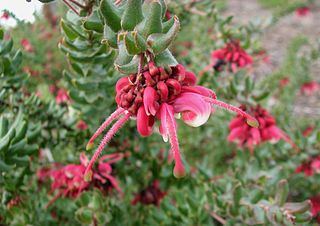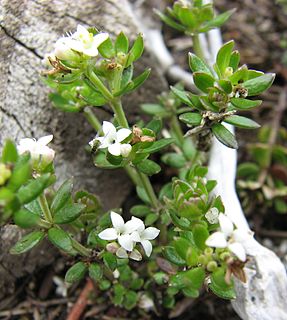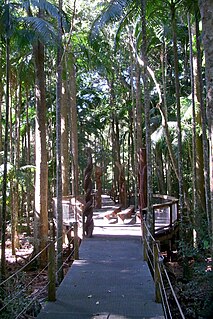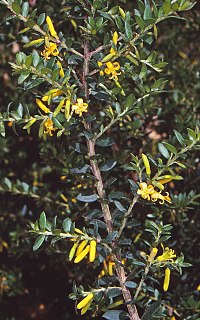
Biriwal Bulga National Park is an Australian national park in New South Wales. It is approximately 45 km north west of Taree and 60 km west of Port Macquarie on the Bulga Plateau.

Booti Booti National Park is a national park in New South Wales, Australia, 282 kilometres (175 mi), by road, north-north-east of Sydney. The holiday town of Forster-Tuncurry lies immediately to the north.

The Brisbane Water National Park is a protected national park that is located in the Central Coast region of New South Wales, in eastern Australia. The 11,506-hectare (28,430-acre) national park is situated 47 kilometres (29 mi) north of Sydney, 10 kilometres (6.2 mi) west of Woy Woy, and 12 kilometres (7.5 mi) southwest of Gosford.

Conjola National Park covers 11,060 hectares and lies on the mid south coast of New South Wales, Australia, between Sussex Inlet and Lake Conjola, 165 km southwest of Sydney.

The New England National Park is a protected national park located on the Northern Tablelands in the New England region of New South Wales, Australia. The 67,303-hectare (166,310-acre) park was created in May 1935 and is situated approximately 560 kilometres (350 mi) north of Sydney, and 10 kilometres (6.2 mi) south of Waterfall Way, just 85 kilometres (53 mi) east of Armidale and 65 kilometres (40 mi) west of Coffs Harbour. The closest village to New England National Park is Ebor, located 20 kilometres (12 mi) away.

The Werrikimbe National Park is a protected national park located in the catchment zone of the Upper Hastings River in New South Wales, Australia. Gazetted in 1975, the 33,309-hectare (82,310-acre) park is situated approximately 486 kilometres (302 mi) north of Sydney, 65 kilometres (40 mi) north-west of Wauchope, and 90 kilometres (56 mi) east of Walcha on the eastern escarpment of the Great Dividing Range.

The Hunter Region, also commonly known as the Hunter Valley, is a region of New South Wales, Australia, extending from approximately 120 km (75 mi) to 310 km (193 mi) north of Sydney. It contains the Hunter River and its tributaries with highland areas to the north and south. Situated at the northern end of the Sydney Basin bioregion, the Hunter Valley is one of the largest river valleys on the NSW coast, and is most commonly known for its wineries and coal industry.

Wolli Creek is an urban watercourse of the Cooks River catchment located in the southern suburbs of Sydney, in New South Wales, Australia.

Asperula, commonly known as woodruff, is a genus of flowering plants in the family Rubiaceae. It contains 194 species and has a wide distribution area from Europe, northern Africa, temperate and subtropical Asia to Australasia.

Asperula orientalis, known as annual woodruff or oriental woodruff, is a species of flowering plant in the family Rubiaceae. It is found in Turkey, western Syria, Iraq, the Caucasus and Iran. It is often used as an ornamental plant in various regions and is reportedly naturalized in Oregon, North Dakota and the Czech Republic.

Grevillea baueri, commonly known as Bauer's grevillea, is a species of flowering plant in the family Proteaceae and is endemic to the coastal ranges of south-eastern New South Wales. It is a low, spreading to erect shrub with mostly oblong to egg-shaped leaves with red to pink and cream-coloured or yellow flowers.

Asperula gunnii, the mountain woodruff, is a species of flowering plant in the family Rubiaceae. It is a perennial herb that is endemic to Australia.

Terrigal Lagoon, an intermittently closed intermediate saline coastal lagoon, is located on the Central Coast region of New South Wales, Australia. Terrigal Lagoon is located between the towns of Terrigal and Wamberal, and adjacent to the east coast, about 85 kilometres (53 mi) north of Sydney.

Persoonia glaucescens, commonly known as the Mittagong geebung, is a species of flowering plant in the family Proteaceae and is endemic to New South Wales. It is an erect shrub with smooth bark, hairy young branchlets, lance-shaped leaves with the narrower end towards the base, and yellow flowers. It is the only persoonia in eastern Australia with strongly glaucous leaves.

The Sea Acres National Park is a national park that is located in the Mid North Coast region of New South Wales, in eastern Australia. The 76-hectare (190-acre) park is situated near the town of Port Macquarie. The park is a popular tourist area with a 1.3-kilometre (0.81 mi) long boardwalk through a remnant of seaside rainforest. There is also an education centre and cafe. The park was initially declared as a nature reserve in 1987; and gazetted as a national park in October 2010.

Persoonia asperula, commonly known as mountain geebung, is a plant in the family Proteaceae and is endemic to south-eastern Australia. It is an erect or prostrate shrub with smooth bark, mostly elliptic to oblong leaves and yellow flowers borne singly or in groups of up to nine. It mostly occurs in the Southern Highlands of New South Wales. A small population in Victoria may be a different species.
Asperula pusilla, commonly known as alpine woodruff, is a species of flowering plant in the family Rubiaceae. It is a perennial herb that is endemic to Australia.

Limeburners Creek National Park is a protected national park on the Mid North Coast of New South Wales, Australia. The 91.2 km national park is located 5 km (3.1 mi) to the north of Port Macquarie and exists across both the Kempsey Shire and Port Macquarie-Hastings Council local government areas, but is chiefly managed by National Parks and Wildlife Service. The area was originally erected as a nature reserve but this reservation was revoked when it became formally recognised as a national park in 2010 under the National Parks and Wildlife Act (1974). Many threatened ecological habitats and species of fauna and flora are found within this park, alongside several heritage sites of cultural significance, particularly to the local Birpai and Dunghutti people upon whose land the park exists. The protected status of this national park is largely owing to the ecological and cultural value of the area, in addition to the value of the ecosystems to further scientific research.

Asperula conferta is a species of flowering plant in the family Rubiaceae. It is Australian endemic distributed across Queensland, New South Wales, Victoria, Tasmania, South Australia and the Northern Territory.
Asperula acuminata is a deciduous species of perennial groundcover, and a flowering plant in the family Rubiaceae, known as Woodruff, and is endemic to NE. New South Wales of Australia, and was first named by I.Thomps.


















